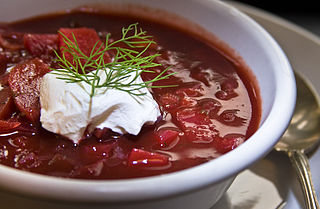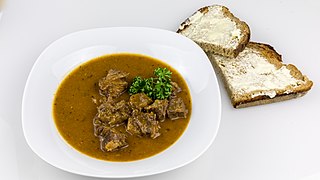Related Research Articles

Simmering is a food preparation technique by which foods are cooked in hot liquids kept just below the boiling point of water and above poaching temperature. To create a steady simmer, a liquid is brought to a boil, then its heat source is reduced to a lower, constant temperature.

Borscht is a sour soup common in Eastern Europe and Northern Asia. In English, the word "borscht" is most often associated with the soup's variant of Ukrainian origin, one of the most famous dishes of Ukrainian cuisine, made with beetroots as one of the main ingredients, which give the dish its distinctive red color. The same name, however, is also used for a wide selection of sour-tasting soups without beetroots, such as sorrel-based green borscht, rye-based white borscht and cabbage borscht.

A mirepoix is a flavor base made from cooked, diced vegetables, usually with butter, oil, or other fat, for a long time on a low heat without coloring or browning, as further cooking, often with the addition of tomato purée, creates a darkened brown mixture called pincage. It is not sautéed or otherwise hard cooked, because the intention is to sweeten the ingredients rather than caramelize them. It is a long-standing cooking technique in French cuisine.

Brisket is a cut of meat from the breast or lower chest of beef or veal. The beef brisket is one of the nine beef primal cuts, though the definition of the cut differs internationally. The brisket muscles include the superficial and deep pectorals. As cattle do not have collar bones, these muscles support about 60% of the body weight of standing or moving cattle. This requires a significant amount of connective tissue, so the resulting meat must be cooked correctly to tenderise it.

Russian cuisine is a collection of the different cooking traditions of the Russian people. The cuisine is diverse, with Northern and Eastern European, Caucasian, Central Asian, Siberian, and East Asian influences. Its foundations were laid by the peasant food of the rural population in an often harsh climate, with a combination of plentiful fish, pork, poultry, caviar, mushrooms, berries, and honey. Crops of rye, wheat, barley and millet provided the ingredients for a plethora of breads, pancakes, pies, cereals, beer and vodka. Soups and stews are centered on seasonal or storable produce, fish and meats. Such food remained the staple for the vast majority of Russians well into the 20th century. Soviet cuisine had a separate character of its own.

Cambodian cuisine or Khmer cuisine, is the cuisine of the people of Cambodia which is heavily influenced by Chinese, Thai, and Vietnamese cuisine.
Latvian cuisine typically consists of agricultural products, with meat featuring in most main meal dishes. Fish is commonly consumed due to Latvia's location on the east coast of the Baltic Sea.
Croatian cuisine is heterogeneous and is known as a cuisine of the regions, since every region of Croatia has its own distinct culinary tradition. Its roots date back to ancient times. The differences in the selection of foodstuffs and forms of cooking are most notable between those in mainland and those in coastal regions. Mainland cuisine is more characterized by the earlier Slavic and the more recent contacts with Hungarian and Turkish cuisine, using lard for cooking, and spices such as black pepper, paprika, and garlic. The coastal region bears the influences of the Greek and Roman cuisine, as well as of the later Mediterranean cuisine, in particular Italian. Coastal cuisines use olive oil, herbs and spices such as rosemary, sage, bay leaf, oregano, marjoram, cinnamon, clove, nutmeg, and lemon and orange rind. Peasant cooking traditions are based on imaginative variations of several basic ingredients and cooking procedures, while bourgeois cuisine involves more complicated procedures and use of selected herbs and spices. Charcuterie is part of the Croatian culinary tradition in all regions. Food and recipes from other former Yugoslav countries are also popular in Croatia.

Burmese cuisine is mainly an amalgam of cuisines from various regions of Myanmar. It has also been influenced by various cuisines of neighbouring countries, in particular, China, India and Thailand.

Ghanaian cuisine is the cuisine of the Ghanaian people. Ghanaian main dishes are organized around a starchy staple food, with which goes a sauce or soup containing a protein source. The main ingredient for the vast majority of soups and stews are tomatoes- canned or fresh tomatoes can be used. As a result, nearly all Ghanaian soups and stews are red or orange in appearance.
Tatar cuisine is primarily the cuisine of the Volga Tatars, who live in Tatarstan, Russia, and surrounding areas.

Split peas are an agricultural or culinary preparation consisting of the dried, peeled and split seeds of Pisum sativum, the pea.

Oxtail soup is made with beef tails. The use of the word "ox" in this context is a legacy of nomenclature; no specialized stock of beef animals are used and tails may come from bovines other than oxen. It is believed by some that oxtail soup was invented in Spitalfields in London in the seventeenth century by French Huguenot and Flemish immigrants, from the tails of animals. Different versions of oxtail soup exist: Korean, Chinese, a fried/barbecued oxtail combined with soup variation which is a popular dish in Indonesia where it is called as sop buntut. An ethnic dish of the American South which traces its lineage back to the pre-revolutionary war era, and a thick, rich, gravy-like soup popular in the United Kingdom since the 18th century. Creole oxtail soup is made from a tomato base with oxtails, potatoes, green beans, corn, mirepoix, garlic, and herbs and spices.

West African cuisine encompasses a diverse range of foods that are split between its 16 countries. In West Africa, many families grow and raise their own food, and within each there is a division of labor. Indigenous foods consist of a number of plant species and animals, and are important to those whose lifestyle depends on farming and hunting.

Fruit soup is a soup prepared using fruit as a primary ingredient, and may be served warm or cold depending on the recipe. Some fruit soups use several varieties of fruit, and alcoholic beverages such as rum, sherry and kirsch may be used. Fruit soup is sometimes served as a dessert.

Soup is a primarily liquid food, generally served warm or hot, that is made by combining ingredients of meat or vegetables with stock, or water. Hot soups are additionally characterized by boiling solid ingredients in liquids in a pot until the flavors are extracted, forming a broth. Soups are similar to stews, and in some cases there may not be a clear distinction between the two; however, soups generally have more liquid (broth) than stews.

Puchero is a type of stew originally from Spain, prepared in Yucatán, Mexico, Argentina, Paraguay, Uruguay, Perú, south of Brazil, the Philippines, and Spain, specifically the autonomous communities of Andalusia and the Canary Islands. The Spanish word "puchero" originally meant an earthenware pot, before being extended to mean any vessel, and then the dish cooked in it.

Cheese soup is a type of soup prepared using cheese as a primary ingredient, along with milk, broth and/or stock to form its basis. Various additional ingredients are used in its preparation, and various types and styles of cheese soup exist. It is a part of some cuisines in the world, such as American, Colombian, Mexican, Swiss, French, and Tibetan cuisines. Mass-produced cheese soups may be prepared with the addition of food additives to preserve them and enhance flavor. A list of cheese soups is included in this article.

Lettuce soup is a soup prepared with lettuce as a primary ingredient. It may be prepared with myriad lettuces and other ingredients, and some lettuce soups may use several cultivars of lettuce in their preparation. It is a part of French cuisine and Chinese cuisine. Cream of lettuce soup is a type of lettuce soup prepared using milk or cream. The soup may be served with toast or rolls as a side dish or with the soup atop them. It may be served as an appetizer, a side dish or as a main dish, and may be served hot or cold.
Ashkenazi Jewish cuisine is an assortment of cooking traditions that developed among the Jews of Eastern, Central, Western, Northern, and Southern Europe, and their diaspora mainly concentrated in North America and other Western countries. Ashkenazi Jews have also been known as Western Jews. Jews of the Ashkenazi communities cook foods that were often unique to their community, while often using local ingredients, and following the laws of kashrut. The cuisine is based largely on ingredients that were affordable for the historically poor Ashkenazi Jewish community of Europe, often composed of ingredients that were readily available in Europe and affordable and which were perceived to be less desirable and rarely used by their gentile neighbors, such as brisket, chicken liver, and artichokes, among other ingredients. As Ashkenazi Jews were typically forbidden to grow crops in their home countries in Europe, their cuisine reflects that and there are less vegetable-focused dishes in Ashkenazi Jewish cuisine compared to their Sephardi and Mizrahi counterparts. Meat is ritually slaughtered in the shehita process, and is soaked and salted. Meat dishes are a prominent feature of sabbath, festival, and celebratory meals. Braised meats such as brisket feature heavily, as do root vegetables such as potatoes, carrots, and parsnips which are used in such dishes as latkes, matzo ball soup, and tzimmes. Cooked, stuffed and baked vegetables such as stuffed cabbage are central to the cuisine. Due to the lack of availability of olive oil and other fats traditionally used in Jewish cooking, fat from leftover chicken and goose skins (gribenes) called schmaltz is traditionally used in fleishig (meat) dishes, while butter is traditionally used in milchig (dairy) dishes.
References
- 1 2 Harvey A. Levenstein (May 30, 2003). Paradox of Plenty: A Social History of Eating in Modern America, Part 12. University of California Press. p. 129.
- ↑ "Vogue's Soup & Seasoning Bases". Vogue Cuisine. 2011. Archived from the original on March 17, 2012. Retrieved May 16, 2012.
| This food ingredient–related article is a stub. You can help Wikipedia by expanding it. |